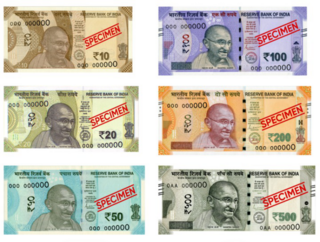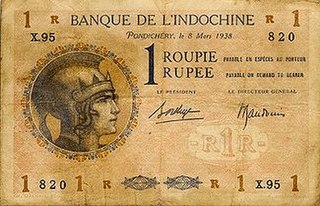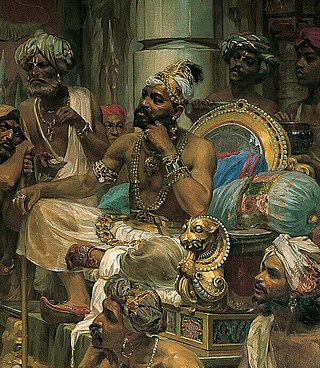
In economics, cash is money in the physical form of currency, such as banknotes and coins.

The shilling is a historical coin, and the name of a unit of modern currencies formerly used in the United Kingdom, Australia, New Zealand, other British Commonwealth countries and Ireland, where they were generally equivalent to 12 pence or one-twentieth of a pound before being phased out during the 1960s and 1970s.

The Kingdom of Travancore, also known as the Kingdom of Thiruvithamkoor, was an Indian kingdom from c. 1729 until 1949. It was ruled by the Travancore Royal Family from Padmanabhapuram, and later Thiruvananthapuram. At its zenith, the kingdom covered most of the south of modern-day Kerala and the southernmost part of modern-day Tamil Nadu with the Thachudaya Kaimal's enclave of Irinjalakuda Koodalmanikyam temple in the neighbouring Kingdom of Cochin. However Tangasseri area of Kollam city and Anchuthengu near Attingal in Thiruvananthapuram were parts of British India. Bordering the kingdom were the five Tamil-majority Taluks of Madras Presidency to the north, Madurai and Tirunelveli districts of Pandya Nadu region in Madras Presidency to the east, the Indian Ocean to the south, and the Arabian Sea to the west. As of the 1911 Census of India, Travancore was divided into five: Padmanabhapuram, Trivandrum, Quilon, Kottayam, and Devikulam, of which the first and last were predominantly Tamil-speaking areas.

The Indian rupee is the official currency in the Republic of India. The rupee is subdivided into 100 paise. The issuance of the currency is controlled by the Reserve Bank of India. The Reserve Bank manages currency in India and derives its role in currency management on the basis of the Reserve Bank of India Act, 1934.

Idukki (ഇടുക്കി), IPA: [iɖukːi], is one of the 14 districts in the Indian state of Kerala. Idukki district lies amid the Cardamom Hills of Western Ghats in Kerala. Idukki district contains two municipal towns - Kattappana and Thodupuzha. The district currently includes five taluks in it.

Travancore–Cochin, or Thiru–Kochi, was a short-lived state of India (1949–1956). It was originally called United State of Travancore and Cochin following the merger of two former kingdoms, Travancore and Cochin on 1 July 1949. Its original capital was Thiruvananthapuram. It was renamed State of Travancore–Cochin in January 1950. Travancore merged with erstwhile princely state of Cochin to form Travancore–Cochin in 1950. The five Tamil-majority Taluks of Vilavancode, Kalkulam, Thovalai, Agastheeswaram, and Sengottai were transferred from Travancore-Cochin to Madras State in 1956. The Malayalam-speaking regions of the Travancore–Cochin merged with the Malabar District and the Kasaragod Taluk of South Canara district in Madras State to form the modern Malayalam-state of Kerala on 1 November 1956, according to the States Reorganisation Act, 1956 passed by the Government of India.

The Coinage of India began anywhere between early 1st millennium BCE to the 6th century BCE, and consisted mainly of copper and silver coins in its initial stage. The coins of this period were Karshapanas or Pana. A variety of earliest Indian coins, however, unlike those circulated in West Asia, were stamped bars of metal, suggesting that the innovation of stamped currency was added to a pre-existing form of token currency which had already been present in the Janapadas and Mahajanapada kingdoms of the Early historic India. The kingdoms that minted their own coins included Gandhara, Kuntala, Kuru, Magadha, Panchala, Shakya, Surasena, Surashtra and Vidarbha etc.
Coins of the Indian rupee (INR) were first minted in 1950. New coins have been produced annually since then and they make up a valuable aspect of the Indian currency system. Today, circulating coins exist in denominations of One Rupee, Two Rupees, Five Rupees, Ten Rupees and Twenty Rupees. All of these are produced by four mints located across India, in Kolkata, Mumbai, Hyderabad, Noida.

The roupie or rupee was the currency of French India. It was equal to the Indian rupee issued by the British and then Indian governments. One rupee was worth 2.40 francs-or. Until 1871 it was issued as coins with the roupie divided into 8 fanons, each of 3 doudous or 20 cash. From 1891, banknotes were issued by the Banque de l'Indochine, which circulated alongside coins issued by British India.

The Travancore rupee was a type of currency issued by the erstwhile Indian princely state of Travancore, which was primarily located in the modern Indian state of Kerala. The rupee was largely a newer currency in comparison to the older currencies of Kerala such as the Fanams, Achus, Chuckrams as well as the Kasu. Its creation was probably intended for the increased trading with British India and the high-value transactions therein.
The fanam was a currency issued by the Madras Presidency until 1815. It circulated alongside the Indian rupee, also issued by the Presidency. The fanam was a small silver coin, subdivided into 80 copper cash, with the gold pagoda worth 42 fanams. The rupee was worth 12 fanams. After 1815, only coins of the rupee currency system were issued.
Fanam was the currency used historically in major parts of South India, especially during the British Raj. Fanam is the anglicized form of the native word paṇaṁ, meaning "coin" or "wealth".
Cash is a name for several historical currencies used in Asia. It is applied to units used in China, Vietnam, and of Madras and Princely state of Travancore in British India. It is also occasionally used to refer to the Korean mun and the Japanese mon.

The pagoda was a unit of currency, a coin made of gold or half-gold minted by Indian dynasties as well as the British, the French and the Dutch. It was subdivided into 42 fanams. The pagoda was issued by various dynasties in medieval southern India, including the Kadambas of Hangal, the Kadambas of Goa, and the Vijayanagara Empire.

The Samoothiri was the hereditary Nair monarch and ruler of the Kingdom of Kozhikode (Calicut) in the South Malabar region of India. Originating from the former feudal kingdom of Nediyiruppu Swaroopam, the Samoothiri and his vassal kings from Nilambur Kovilakam established Calicut as one of the most important trading ports on the southwest coast of India. At the peak of their reign, they ruled over a region extending from Kozhikode Kollam (Kollam) to the forested borders of Panthalayini Kollam (Koyilandy). The Zamorins belonged to the Eradi caste of the Samantan Nair community of medieval Kerala.
Devaswom are socio-religious trusts in India, whose members are nominated by the government and community. They oversee Hindu temples and their assets to ensure their smooth operation in accordance with traditional rituals and customs. The devaswom system notably exists in the state of Kerala, where most temples are either managed by Government of Kerala-controlled devaswoms or private bodies or families. The properties of each temple are deemed to be the personal property of the presiding deity of the temple, and are managed through a body of trustees who bear allegiance to that deity.

The population of Kerala, India is a heterogenous group that comprises many ethnic groups that originated in other parts of India as well as the world, with distinctive cultural and religious traditions. While the majority of Keralites speak the Malayalam language, various ethnic groups may speak other languages as well.
The Travancore rebellion against the British East India Company was led by the prime ministers of the Indian states of Travancore and Cochin in 1808–09 with support from Sikhs ruling Punjab.

Quilon or Coulãopronunciation (help·info), officially Kollampronunciation (help·info) is one of the ancient civilizations in India.It is one of the oldest port cities in the Malabar Coast and was the capital city of historic Venad Kingdom and Travancore Kingdom. Quilon was once an important trading port in India. It was also known as Desinganadu. It is now known as the "Cashew Capital of the World".

The Indian 1-rupee coin (₹1) is an Indian coin worth one Indian rupee and is made up of a hundred paisas. Currently, one rupee coin is the smallest Indian coin in circulation. Since 1992, one Indian rupee coins are minted from stainless steel. Round in shape, the one rupee coins weighs 3.76 grams, has a diameter of 21.93-millimetre (0.863 in) and thickness of 1.45-millimetre (0.057 in). In independent India, one rupee coins was first minted in 1950 and is currently in circulation.















